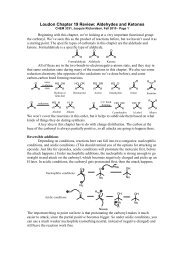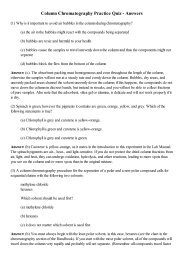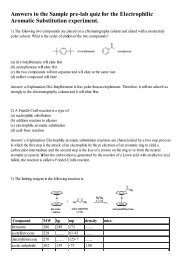7 - Isolation of Limonene.pdf
7 - Isolation of Limonene.pdf
7 - Isolation of Limonene.pdf
Create successful ePaper yourself
Turn your PDF publications into a flip-book with our unique Google optimized e-Paper software.
Experiment 7<br />
<strong>Isolation</strong> <strong>of</strong> (+)-<strong>Limonene</strong> from Orange Zest<br />
Reading: Handbook for Organic Chemistry Lab, Sections on Steam Distillation and IR Spectroscopy.<br />
<strong>Limonene</strong>, the chief component <strong>of</strong> orange oil, is widely used as a fragrance and flavoring, as well as a<br />
cleaning solvent. <strong>Limonene</strong> is an example <strong>of</strong> a terpene, a class <strong>of</strong> natural products biosynthesized by the<br />
assembly <strong>of</strong> isoprene units into various structures (Figure 7.1). Many terpenes are responsible for the<br />
odors <strong>of</strong> plants like eucalyptus, pine, mint, lavender, rose, and others.<br />
Figure 7.1 » The structures <strong>of</strong> some naturally occurring terpenes, including limonene.<br />
The distinguishing feature <strong>of</strong> terpenes is that they are made up <strong>of</strong> five-carbon isoprene units. The<br />
structure <strong>of</strong> isoprene contains double bonds (Figure 7.2), but these may or may not be present in the<br />
terpene. Terpenes, <strong>of</strong>ten referred to as isoprenoid compounds, are classified according to the number <strong>of</strong><br />
carbon atoms that they contain: 10 carbons (2 isoprene units) is a monoterpene, 15 is a sesquiterpene, 20<br />
is a diterpene, 25 is a sesterpene, 30 is a triterpene, and 40 is a tetraterpene.<br />
Figure 7.2 » The structure <strong>of</strong> isoprene, and the isoprene units <strong>of</strong> limonene and farnesol.<br />
Organic chemists use terpenes and other natural products as chiral starting materials for complex<br />
chemical syntheses or as inspirations for pharmaceuticals. Some natural products are attractive synthetic<br />
targets because <strong>of</strong> interesting or unusual structural features or medicinal applications.<br />
<strong>Isolation</strong> <strong>of</strong> natural products typically involves multiple extractions and chromatographic steps, but<br />
certain organic oils can be freed <strong>of</strong> contamination by subjecting them to a process known as steam<br />
distillation. In today’s lab, you will perform a steam distillation to isolate limonene from the peelings <strong>of</strong><br />
citrus fruit. You will then use IR spectroscopy and polarimetry to analyze your isolated limonene.<br />
Steam Distillation<br />
Normally, a liquid boils when its vapor pressure is equal to the surrounding pressure. Generally, this is<br />
the same as the atmospheric pressure (1 atm or 760 mm Hg). A solution that is a homogeneous mixture<br />
<strong>of</strong> two or more miscible liquids will boil when the combined vapor pressures <strong>of</strong> its dissolved<br />
components is equal to the surrounding pressure. The pressure <strong>of</strong> each component in a solution is<br />
related to its concentration in the mixture, and so the boiling point <strong>of</strong> a solution, or homogeneous<br />
37
Experiment 7: <strong>Isolation</strong> <strong>of</strong> <strong>Limonene</strong><br />
mixture, is normally between the boiling points <strong>of</strong> the individual components. This was the case for the<br />
Simple and Fractional Distillation experiment performed previously in this class.<br />
A heterogeneous mixture <strong>of</strong> two immiscible liquids will also boil when the combined vapor pressures <strong>of</strong><br />
its components is equal to the surrounding pressure. However, because the liquids are immiscible, the<br />
vapor pressures <strong>of</strong> the individual components are independent <strong>of</strong> one another and not related to their<br />
concentrations. The two liquids independently exert vapor pressures against the external pressure, and<br />
when the sum <strong>of</strong> the partial pressures is equal to the external pressure, boiling occurs. Thus, the total<br />
vapor pressure <strong>of</strong> a heterogeneous mixture is given by the following equation:<br />
Ptotal = P° A + P° B<br />
where Ptotal is the total pressure <strong>of</strong> a system at a given temperature, and P° A and P° B are the individual<br />
pressures <strong>of</strong> components A and B at the given temperature. Generally, a heterogeneous mixture will boil<br />
at some temperature below the boiling point <strong>of</strong> either component. In Figure 7.3, individual vapor<br />
pressures are plotted against temperature. Pure compound B, which has the lower boiling point, will boil<br />
at a temperature slightly above 125 °C. But when compound A is also present, the combined pressures<br />
add up to 760 mm—and the mixture boils—when the temperature is about 85 °C. This boiling<br />
temperature is lower than the boiling point <strong>of</strong> either compound alone, and it is the result <strong>of</strong> the<br />
combined effects <strong>of</strong> both compounds.<br />
vapor pressure curve for pure A<br />
38<br />
T (˚C)<br />
125<br />
100<br />
75<br />
50<br />
25<br />
200<br />
400 600 800<br />
vapor pressure<br />
curve for pure B<br />
P (mm mercury)<br />
Figure 7.3 » Effects <strong>of</strong> combined pressures in heterogeneous distillations.<br />
We can take advantage <strong>of</strong> the fact that many water-insoluble liquids and solids behave in the manner<br />
described above for heterogeneous mixtures, volatilizing at temperatures below their boiling points. The<br />
effect described above is exploited in a technique called steam distillation, where an organic compound<br />
<strong>of</strong> moderate volatility and vapor pressure is distilled as part <strong>of</strong> a heterogeneous mixture with water. The<br />
boiling point <strong>of</strong> the mixture is slightly below 100°C, the boiling point <strong>of</strong> water. At this temperature, a<br />
fraction <strong>of</strong> the distillate will be the compound <strong>of</strong> interest. The greater the vapor pressure <strong>of</strong> the organic<br />
compound, the larger the fraction that will co-distill with the water. This technique is considerably<br />
gentler than regular distillation, since some organic compounds can decompose at temperatures<br />
approaching their true boiling points.<br />
Since the amount <strong>of</strong> water is constantly decreasing during the procedure, a steam distillation is<br />
performed with the frequent addition <strong>of</strong> small amounts <strong>of</strong> water. Traditionally, this is done by using a<br />
setup similar to that shown in Figure 7.4. A separatory funnel is placed above the round-bottom flask<br />
and is used to add water to it.
water<br />
Experiment 7: <strong>Isolation</strong> <strong>of</strong> <strong>Limonene</strong><br />
Figure 7.4 » Traditional steam-distillation set-up. The use <strong>of</strong> a separatory funnel allows water to be added<br />
frequently.<br />
In the interests <strong>of</strong> completing this lab within the allotted time, you will not be using this setup. The use<br />
<strong>of</strong> a Claisen adaptor makes the distillation path too long, and slows the distillation down enough that<br />
limonene collects very slowly in the receiving flask. Instead, you will use the same setup that you used<br />
for the Simple and Fractional Distillation lab, shown in Figure 7.5.<br />
round bottom<br />
flask<br />
heat source<br />
goes here<br />
thermometer<br />
Y-adaptor<br />
water out<br />
water out<br />
condenser<br />
water in<br />
Figure 7.5 » Glassware set-up for the steam distillation <strong>of</strong> limonene. Make sure that you clamp the apparatus<br />
securely to ring stands.<br />
To add water to the flask, you will periodically remove the thermometer and thermometer adapter, and<br />
pour water in through the y-adaptor.<br />
During the distillation, a process known as “bumping” may occur. This involves large bubbles <strong>of</strong> liquid<br />
and vapor erupting into the Y-adaptor and possibly flowing into the collection flask. Bumping is caused<br />
by the liquid superheating without becoming a vapor, due to overly fast heating. It can be prevented by<br />
heating more slowly and by not filling the distillation flask more than halfway. The use <strong>of</strong> boiling chips<br />
is also helpful in preventing boiling.<br />
water in<br />
receiving flask<br />
goes here<br />
39
Experiment 7: <strong>Isolation</strong> <strong>of</strong> <strong>Limonene</strong><br />
Polarimetry<br />
Chiral, non-racemic compounds have the ability to rotate polarized light. This phenomenon is known as<br />
circular birefringence, and is where the phrase “optically active” comes from. The specific rotation <strong>of</strong> a<br />
material is an intrinsic, constant value at a given temperature and wavelength <strong>of</strong> light; specific rotation<br />
can be found by using polarimetry. The polarimeter consists <strong>of</strong> a glass tube with flat ends to hold the<br />
sample, and a polarizing filter at each end <strong>of</strong> the tube. A light is shone onto the mirror at the bottom<br />
end <strong>of</strong> the polarimeter. As the light passes through the first filter it is polarized into a single direction,<br />
but this direction changes as it travels through the tube (if the sample is optically active). When it<br />
reaches the second filter, it may or may not pass through depending on whether it is polarized in the<br />
same direction as the second filter. The second filter is attached to an eyepiece which can be rotated,<br />
causing more or less light to pass through. At the darkest point, a reading can be made from the<br />
markings on the eyepiece which gives the observed rotation.<br />
Specific rotation, [α], is then given by the following formula:<br />
α = α<br />
l ∙ c<br />
where α is the observed rotation in degrees, l is the path length <strong>of</strong> the polarimeter tube in decimeters,<br />
and c is the concentration in g/mL. The literature value for the specific rotation <strong>of</strong> limonene is 124°.<br />
The polarimeter tubes that you will use have a path length <strong>of</strong> 12 cm, or 1.2 dm, and they contain a<br />
volume <strong>of</strong> 35 mL. Your TA will demonstrate how to take a reading on the polarimeters.<br />
Safety Precautions<br />
Pure limonene is an irritant, especially to the eyes, and it is flammable. Ethanol is flammable and toxic.<br />
Be careful that you do not cut yourself with the knife or peeler you use to remove the rind from the<br />
oranges; peel away from yourself, not towards yourself.<br />
Procedure<br />
Peel an orange with a sharp knife or peeler. Remove just the exterior, brightly colored portion <strong>of</strong> the<br />
peel, called the “zest”, as the white material underneath (the pith) contains little or no limonene.<br />
Determine the mass <strong>of</strong> the peelings then place them in a blender. Add about 50 mL water, put the lid on<br />
the blender, and blend the mixture until a smooth puree is obtained. Pour 50mL <strong>of</strong> this puree into your<br />
100 mL round-bottom flask. (It is not necessary to get all the solids into the flask – much <strong>of</strong> the<br />
limonene will be in the liquid, if you have blended it enough). Add several boiling chips. Attach the flask<br />
to the steam distillation system shown in Figure B.5. Use a 10mL graduated cylinder for the receiving<br />
flask.<br />
Place a heating mantle under the distillation flask, connect the heating mantle to a Variac, and heat to<br />
boiling (Variac setting 60-70). Do not heat the flask too quickly, as this may cause the contents <strong>of</strong> the<br />
distillation flask to bump and contaminate the product. If this happens you will have to let the apparatus<br />
cool down, pour all the recovered distillate back into the distillation flask, clean the collection flask and<br />
condenser, and begin again.<br />
Periodically add 5 to 10 mL portions <strong>of</strong> water to the distillation flask to replace the water that has been<br />
distilled over. Try to maintain the liquid level in the distillation flask at about half-full. You can add<br />
40
Experiment 7: <strong>Isolation</strong> <strong>of</strong> <strong>Limonene</strong><br />
water easily by removing remove the thermometer and thermometer adapter, and pouring water in<br />
through the y-adaptor.<br />
As the distillation proceeds, you should notice an upper layer <strong>of</strong> limonene forming in the 10 mL<br />
graduated cylinder. When the graduated cylinder is close to full, remove this layer with a Pasteur pipet<br />
and put it into a clean, tared vial. Pour <strong>of</strong>f the remaining water into a beaker and set it aside; return the<br />
graduated cylinder to its place and continue distilling. Continue this process until there are about 45<br />
minutes left in the lab period.<br />
In the vial you may notice some droplets <strong>of</strong> immiscible water underneath your limonene layer, if you<br />
accidentally transferred some water to the vial along with your product. In this case, you can dry the<br />
limonene by adding a very small amount <strong>of</strong> sodium sulfate and then pipetting it to a new clean, tared<br />
vial.<br />
Find the mass <strong>of</strong> the isolated limonene and obtain an IR spectrum. Pool your sample with the other<br />
students in the class and measure the optical rotation <strong>of</strong> the sample in ethanol using the polarimeter. If<br />
there is a large amount <strong>of</strong> water in the class pool <strong>of</strong> limonene, a separatory funnel may be useful to<br />
separate the layers.<br />
Wastes<br />
Place excess pulp into the containers marked “Waste Pulp”. Do not pour pulp into the sink. Place any<br />
excess limonene and ethanol (from the polarimetry) in the recovery bottle in the main hood.<br />
Study Questions<br />
1) (+)-<strong>Limonene</strong> is the (R)-enantiomer. Draw the structure <strong>of</strong> this enantiomer indicating the proper<br />
stereochemistry at the stereocenter <strong>of</strong> the molecule.<br />
2) If you isolate 5 g <strong>of</strong> limonene and place it in a total volume <strong>of</strong> 35 mL:<br />
a) What would be the observed rotation, α?<br />
b) If the 5 g <strong>of</strong> limonene was actually not pure, what effect would this have on the<br />
observed rotation?<br />
3) What are the major diagnostic IR bands that you would expect to see in limonene?<br />
41
Experiment 7: <strong>Isolation</strong> <strong>of</strong> <strong>Limonene</strong><br />
42













